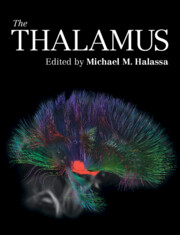Book contents
- The Thalamus
- The Thalamus
- Copyright page
- Contents
- Contributors
- Preface
- Section 1: History
- Section 2: Anatomy
- Section 3: Evolution
- Section 4: Development
- Section 5: Sensory Processing
- Section 6: Motor Control
- Section 7: Cognition
- Chapter 16 The Thalamus in Cognitive Control
- Chapter 17 The Thalamus in Attention
- Chapter 18 The Thalamus in Navigation
- Section 8: Arousal
- Section 9: Computation
- Index
- References
Chapter 16 - The Thalamus in Cognitive Control
from Section 7: - Cognition
Published online by Cambridge University Press: 12 August 2022
- The Thalamus
- The Thalamus
- Copyright page
- Contents
- Contributors
- Preface
- Section 1: History
- Section 2: Anatomy
- Section 3: Evolution
- Section 4: Development
- Section 5: Sensory Processing
- Section 6: Motor Control
- Section 7: Cognition
- Chapter 16 The Thalamus in Cognitive Control
- Chapter 17 The Thalamus in Attention
- Chapter 18 The Thalamus in Navigation
- Section 8: Arousal
- Section 9: Computation
- Index
- References
Summary
Cognitive control refers to our ability to regulate thoughts and actions for adaptive, goal-directed behaviors. Traditionally, cognitive control is thought to be mediated by the prefrontal cortex; however, the thalamus likely plays an important yet underappreciated role. This chapter reviews the role of the human thalamus in cognitive control. We first review anatomical, human functional neuroimaging, and human neuropsychology findings that have investigated the role of the human thalamus in two cognitive control functions: working memory and top-down biasing. To understand how the human thalamus mechanistically supports cognitive control, we then summarize operational principles of thalamocortical circuits from anatomical and neurophysiological studies. Finally, we present an overarching conceptual framework to describe how thalamocortical circuits implement different components of information processing necessary for cognitive control. In conclusion, we refute the traditional view that the thalamus passively relays signals to the cortex for purposeful processing. Instead, emerging evidence suggests that the thalamus actively modulates cortical activity and cortical network interactions to shape and coordinate information processes underlying cognitive control.
Keywords
- Type
- Chapter
- Information
- The Thalamus , pp. 307 - 323Publisher: Cambridge University PressPrint publication year: 2022



